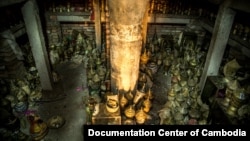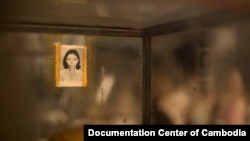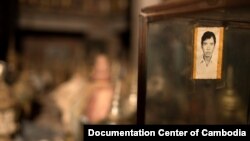More than 100 cremation urns were left at Wat Langka, in Phnom Penh, during the chaotic war period of the 1970s. They have yet to be picked up by the loved ones of the deceased.
But now monks at the pagoda have made public the vault of urns, in hopes of helping people claim them.
The urns are made of iron, clay, or silver. Some are wrapped in white rags. They sit beneath a giant statue of Buddha. They were left behind, or perhaps dropped off there, when the Khmer Rouge came to power, evacuating the city, in April 1975.
Keng Menglong, a former monk who lived at the pagoda at the end of civil war, in 1991, said they were there when he arrived. Over the years, he was able to identify urns and return them to only a few people, Keng Menglong, who is now a tuk-tuk driver, told VOA Khmer in a recent interview.
“At that time I was a novice, and the clergy asked me to help find the urns for people who were looking for theirs,” he said. “I once found urns for a couple and they paid me $20, as a tribute, for finding them the urn.” In total, he was only able to find four urns for people.
Some of the urns are well packed and labeled, but no one ever came to claim them, he said. Some have characters written on them. Some have names on small pieces of paper. Others, however, are broken, or are missing identifying labels. Sometimes, people would come looking for their relatives’ urns, but they wouldn’t be able to find them, Keng Menglong said.
Chhang Youk, executive director of the Documentation Center for Cambodia, recently toured the three rooms where the urns are kept. They were left there when people fled, he said later. It is likely that many people thought the pagoda would better care for the urns than they could, so they brought them there, hoping to return. “Only a few surviving members returned, 40 years later,” he said.
It has since fallen to the monks of the pagoda to care for the urns and to help people find them. Srey Yeing, a priest at the pagoda since 1999, said he was able to help two out of six families who came looking for urns.
“Some of them who could not find their parents’ urns cried very hard,” he said. “They were crying and saying they were sorry that they could not find their parents’ urns. They lit incense, saying sorry to their dead parents, asking to forgive them for not being able to find their urns, and to still protect them.”
Phan Chan Dara, deputy chief of monks at the pagoda, said he didn’t know about the urns until he gained some seniority there. Even though he’d been a monk there since 1996, he only heard about the urns in 2008, when people came seeking theirs. Lately, no one has come looking, he said.
“We have not seen people come looking for the urns in the last few years,” Srey Yeing said.
By making their presence public, the monks at the pagoda hope more people will come, to finally get the urns to their proper place.








